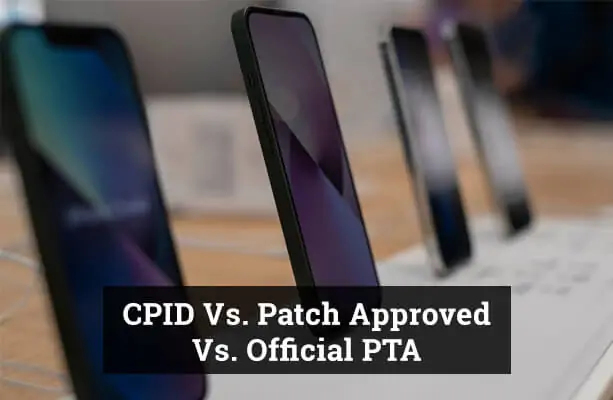When buying a mobile phone in Pakistan, one must consider the different approval methods set forth by the Pakistan Telecommunication Authority (PTA). Specifically, there are three main methods to be aware of: CPID, Patch Approved, and Official PTA Approved. This blog post will delve into each of these to give you a clear understanding of what they entail.
Understanding Official PTA Approval
The term “Official PTA Approved” refers to mobile phones that have been officially sanctioned by the PTA.
Advantages of Official PTA Approval
- Legality: This method is legal, ensuring that you are compliant with the country’s regulations.
- Permanent SIM functionality: The SIM will work permanently without any issues.
- No risk of device or SIM blockage: There is no risk of the device or SIM being blocked due to unauthorized use.
Disadvantages of Official PTA Approval
- Heavy tax implication: Purchasing a PTA-approved mobile handset requires you to pay substantial taxes.
- Increased costs of mobile handsets: Due to the approval process, these devices typically cost more.
Understanding Patch Approval
“Patch Approved” is a method that involves getting a mobile phone approved through a patch, essentially replacing the device’s IMEI number with that of a cheaper phone.
Advantages of Patch Approval
- Lower cost: This method is cheaper than obtaining official PTA approval.
Disadvantages of Patch Approval
- Illegality: This method is not legal, putting you at risk of contravening the law.
- Replacement of the IMEI number: The original IMEI number is replaced with that of a cheaper phone.
- Inconsistent functionality with banking apps: There might be problems when using banking applications.
- Security concerns due to device rooting: The phone is in a rooted state, which reduces its security.
- Issues with Android version/firmware updates: Updates to the Android version or firmware might not be possible.
- Problems with phone reset: You may encounter difficulties when resetting the phone.
- Possible need to pay for the patch again: If you reset the phone, you might have to pay the patch fee again.
Understanding CPID Approval
CPID approval is a method that unlocks the device’s original firmware without rooting the device, effectively removing the SIM lock and turning the phone into a fully functional device.
Advantages of CPID Approval
- Unlocks original firmware without rooting: This method allows for the use of original firmware without the need to root the device.
- Removes SIM lock: The SIM lock is removed, making the phone fully functional.
- Turns phone into a fully functional device: The phone becomes fully functional after CPID approval.
- Allows for safe factory resets and firmware updates: You can safely reset the device to factory settings and update the firmware without worrying about any negative repercussions.
- Ensures SIMs will work under all conditions: The SIM will work in all circumstances without any problems.
Disadvantages of CPID Approval
- Higher cost compared to Patch Approval: Although cheaper than Official PTA Approval, CPID approval is more expensive than Patch Approval.
- Limited to Android and single SIM devices/phones: This method can only be applied to Android devices and single SIM phones.
Comparison of the Three Approval Methods
Each approval method has its unique features, benefits, and limitations. Official PTA Approval is legal and guarantees uninterrupted SIM functionality but comes at a higher cost due to heavy taxes. Patch Approval is cheaper but illegal and comes with several issues, like replacement of the IMEI number and potential issues with banking apps. CPID Approval offers a balance between legality and cost but is limited to Android and single SIM devices.
When choosing an approval method, consider your budget, phone type, and how you plan to use the device.
Frequently Asked Questions FAQs
What does CPID mean in the context of mobile phones in Pakistan?
CPID stands for Certificate Product ID. In the context of mobile phones, CPID refers to phones that are network locked and require a specific certificate for unlocking. In Pakistan, this is relevant for phones imported from abroad which might be locked to a particular foreign carrier.
What does Patch Approved signify for mobile devices?
Patch Approved typically refers to phones that have been unlocked using a software patch rather than an official unlock method. While this method can allow the device to be used with local carriers in Pakistan, it may not be as stable or reliable as an officially unlocked or CPID unlocked phone.
How can I check if my mobile phone is officially PTA approved?
To check if a mobile phone is officially approved by the Pakistan Telecommunication Authority (PTA), you can use the DIRBS (Device Identification Registration and Blocking System) system. By entering your device's IMEI number on the DIRBS website or sending it via SMS to a designated number, you can ascertain the phone's PTA registration status.
Are there any consequences of using a non-PTA approved mobile phone in Pakistan?
Yes, using a non-PTA approved mobile phone can lead to the device being blocked or non-functional on Pakistani cellular networks. It's crucial to ensure that imported or purchased devices are registered with PTA to avoid service interruptions.
If I have a Patch Approved phone, should I get it officially PTA approved?
It's always advisable to have your phone officially PTA approved, regardless of its current patch-approved status. Patch approvals might be temporary and can result in inconsistent service. Getting an official PTA approval ensures uninterrupted service and compliance with local regulations.
Conclusion
Understanding the differences between CPID, Patch Approved, and Official PTA Approved is very important when buying a mobile phone in Pakistan. Each method has its own good and bad points. Knowing these can help you make a good decision that suits your needs and your circumstances. This means being aware of the latest rules and guidelines from the PTA to ensure you are complying with the law.
Disclaimer
The data in this article is provided by the author for general awareness purposes and should not be see as legal advice. Always check the current legal rules for cell phone verification from Pakistan Telecommunication Authority (PTA) before buying. The author has no responsibility regarding any activity carried out with regard to this data.



